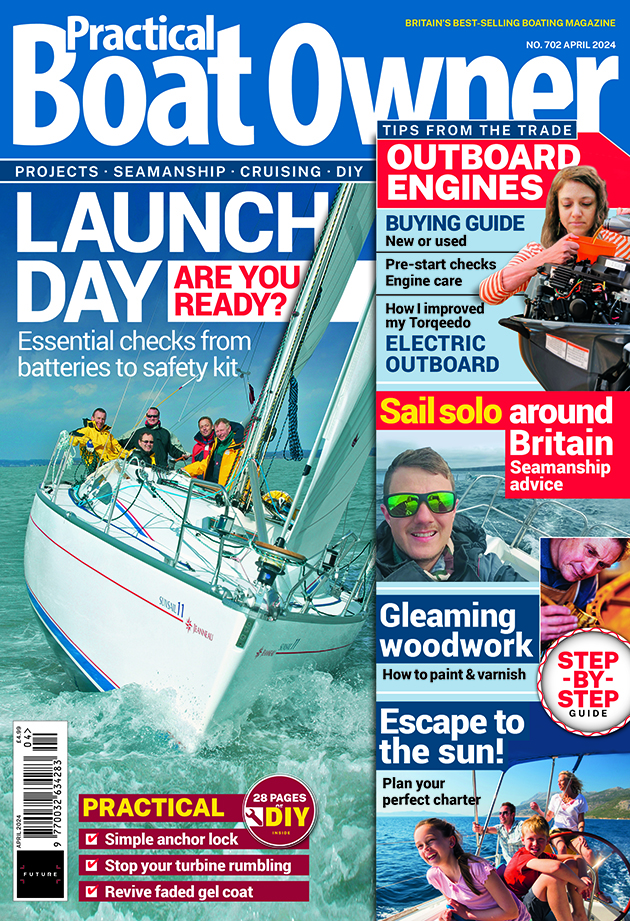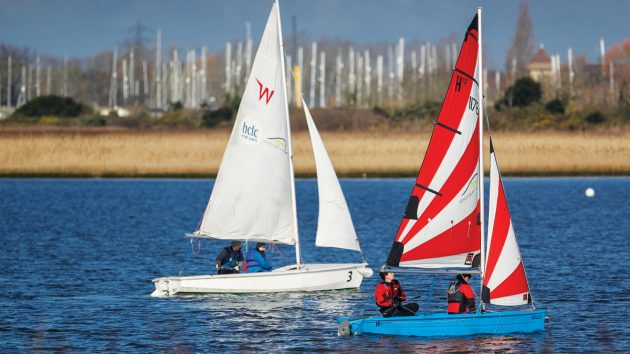What can a lapsed cruising sailor learn from a dinghy course? A lot, as Ali Wood discovers when she returns to the water for her RYA Level 3
Dinghy sailing skills for cruisers
I’ve never capsized on a yacht. As crew, I’ve grounded on sandbanks, hit rocks, lost a chainplate and Chinese-gybed on the Round the Island race, but I’ve always managed to stay dry.
Even on sun-drenched Greek beachclub holidays, I rarely capsized the dinghies – and if I did… well it’s just like taking a bath, isn’t it?
Not in Dorset in the middle of winter, it isn’t. A baptism of ice, you might say.
After three children and an eight-year hiatus from sailing, I was desperate to get back on the water.
I joined Hengistbury Head Adults Sailors Club (HHASC) for a course run by the Hengistbury Head Outdoor Education Centre (HHOEC), an RYA Training Establishment near Christchurch.

Dinghy sailing skills instructor Rob talks through tacking and holding the mainsheet
It’s on the shore of a beautiful harbour; an Iron Age trading port fringed by sandy beaches and wildlife-filled marshes.
For £12 annual membership and £10 pay-as-you-go sailing, it couldn’t have been better.
My rusty Coastal Skipper skills and race crewing experience proved enough to get me round the cans so the senior instructor suggested I take the RYA Level 3 course.
And they were running it at a special pre-season price too good to refuse.
Level 3 is a progression from knowing how to sail – something you can fake on big boats with all the gadgets – to sailing efficiently.
Dinghies, I discovered, are unforgiving.
Chilly start
I woke to a Force 4, scraped the ice off my car, and drove to the club where the slipway had been affected by the weekend’s snowfall.
But any hopes of cancellation were dashed when Henry and Rob, our ebullient instructors, told us to get kitted up.
Decked in thermals, a wetsuit, and a pair of pink Marigolds under my sailing gloves I helped rig the boats – a mixture of Hartley 12s, Wayfarers and Quests.
To begin with, we sailed a triangular course to demonstrate our ability, and practised the five essentials: course, setting, balance, trim and daggerboard. Or, as someone helpfully suggested, the mnemonic ‘children sail better than dads.’
I chose to sail a Quest with my friend Briony. We were having a hoot blasting around in 20-knot gusts, when we capsized at the downwind mark.

Classroom work – the five essentials. Credit: RYA/ Paul Wyeth
Christchurch is a shallow harbour, so when Briony fell on top of the sail, I was trapped underneath it in 3ft of icy water.
Aside from the pain of the cold, I could taste the water; brackish not salty, and was confused by the muffled scrabbling above me.
I could see the sky through the sail, but couldn’t reach it. I pushed up several times before realising that 11sqm of Dacron with a person on top wasn’t going to budge.
There was nothing for it but to swim underneath.
It seems so obvious now, but the shock of cold water can really fuddle your brain!
At the classroom debrief, while hugging my cup of tea to my chest, I discovered why we’d capsized.
“Capsizing on the gybe is a rookie error,” said Henry. “In these winds you want to keep a steady course through the gybe. It should be a nice, slow curving manoeuvre, so once out of the gybe you’ve already had time to make your adjustments.”

Learning new dinghy sailing skills is sociable as well as educational. Credit: RYA/Paul Wyeth
We learned that on the Quest and Hartley you can pull the falls to control the gybe early with your hands – so the boom doesn’t just smash across.
On a Wayfarer you can do this with the kicking strap.
Also, when sailing downwind in strong gusts, by lifting the centreboard three quarters, it won’t bite in and twitch, and will make the gybe smoother.
You’ll skid like a car, rather than heel over. “These things can be done at this standard or Olympic standard and everything in between,” said Rob.
“The more mental effort the less physical effort.” Rob explained the importance of the sitting positions, or ‘trim’. With two crew sitting further apart along the centreline, there was less rocking and more stability going into the gybe.
Formula One tactics
For course efficiency, Rob advised: “Think like a Formula One racing car. Out wide, in tight. Don’t aim for the gybe mark,” he said, pointing to a course drawn on the whiteboard.
“The same applies when you’re coming across the wind. Set yourself two boat-widths away from the buoy so you’ve already tacked and hardened up as you pass it. It’s about pre-empting the course. Tell the crew early because by the time you do it, the helm’s stuck at the back with the mainsheet tied round their feet and the tiller stuck in their bottom!”

Fun on a Quest – with a reefed mainsail. Credit: RYA/Paul Wyeth
Back outside, Henry showed us how to reef as the wind had increased further.
“A tidy boat’s a happy boat,” he quipped, popping the reefing line and halyards into the Quest sail pocket.
He demonstrated tacking using the dagger grip, and how you can sail with the mainsheet behind your back until you’re ready to get into the normal position.
“See how Henry did two-handed pulling,” said Rob. “In heavy winds if you don’t get the sail in fast it starts flogging, the boat leans over and you lose control.”
Back on the water
Donned in wetsuit number two, which I aspired to keep dry, I went back out on the water… and capsized again, this time on the upwind mark.
The tide had taken us so high of the buoy that instead of approaching it close-hauled, we came in on a beam reach and had to change the angle by 80°, not 30°.
Though we were primed for this and sheeted in fast – we didn’t turn quickly enough and became overpowered on a close reach.
We should have either sheeted in slower or headed up quicker.
‘In wide, out tight,’ echoed Rob’s words in my head as I clambered onto the daggerboard and pulled the boat upright.
Later, we practised lying-to, something I’d rarely done on a cruising yacht. It’s a basic technique that dinghy sailors use a lot.
We did hove-tos first (backing the jib, releasing the mainsail and pushing the tiller away) and then moved on to lying to.
Whilst hoving-to takes a while to get out of, lying-to is a quick way to stop, start and control your speed when coming alongside a safety boat or doing ‘follow my leader’.

Dinghy sailing skills instructor Henry helps a student to rig the Quest
It involves nudging into the wind and releasing your sails on a close reach so they flap.
It sounds easy but finding the close reach, then moving into the ‘no go zone’ was harder than I realised.
“Don’t go into the no-go zone for too long, or you’ll get locked in irons,” called Henry. “But don’t go in too quickly either, or you’ll carve into the wind and straight back out. You need to be heading into the wind for quite a while for it to slow your boat down.”
When it finally clicked, I found it so satisfying to be hurtling along one minute then simply come to a gentle stop, and speed up or slow down at my leisure, even in strong winds.
Tomorrow we’d practice man overboard drills when this new technique would really come into its own.
By 4pm we were pretty cold, so returned to the club house and warmed up with tea, cake and a debrief.
We discussed how to find the close reach – when you let your sails out you stop, and when you pull them in you go.

Communication is essential for effective dinghy sailing. Credit: Paul Wyeth/RYA
It’s the only point of sailing you can do this. Rob drew a MOB on the whiteboard, indicated the wind direction, and showed us how to approach the casualty.
“Why can’t you just approach from any direction and turn into the wind?” someone asked. “Because that’s not good seamanship,” he replied.
“You’ll be going far too fast. You need to be in control and approach slowly with your sails flapping. At no point should the boom be flapping as you’re not pointing directly into the wind.”
“Can’t you just hove-to?” asked another. “No, because you’ll go too quickly sideways. You need to lie-to, not hove-to.”
Rob and Henry congratulated us on the first day’s sailing. It’s not easy trying to learn new skills in Force 4-5.
Hopefully tomorrow the wind would be lighter.
Light winds at last
The following day gave us glorious sunshine and not a breath of wind. It couldn’t have been more different.
We started in the classroom, hoping the wind might fill in while we covered some theory.
“Level 2 is about knowing the five essentials,” said Rob. “Level 3 is about the skilful and efficient use of them. In light winds, you need to do everything differently, but the good news is you’ll learn faster.”
He talked us through them:
Making your course
Be especially mindful of the tide, he advised. In light winds, if you aim at the end goal you won’t get there.
Point the boat high of the tide and sail a close-reach, drifting – or ‘ferry-gliding’ – towards the mark.
Take a transit such as a tree and a house behind it. If they drift apart you’re off course.
Daggerboard/centreboard
The good news is that the operation of the centreboard does not change in light winds. Lift it up for downwind sailing.
Trim
Trim was one of the biggest changes we faced compared to the previous day’s conditions.
“In light airs the transom grips the water at the back of the boat – where the rudder sits,” said Rob.
“You see those beautiful America’s Cup sloops where the back lifts off as much as the front? They scoop up to reduce that grip. We can recreate that in our Quest or Hartley 12 by putting weight forward to lift it off the water. This can double your boat speed in light airs.”
Balance
If the wind doesn’t have enough strength to hold the sail, sit on the leeward side to tip the boat so the sail still hangs in a curve.
At the first puff of wind, it will turn into an aerodynamic shape. As soon as you have enough wind, go back to having a flat boat.
“Think about whether you’re over- or underpowered,” said Rob. “Get the crew to do the moving while the helm stays in a sensible sailing position.”
Sail setting
“You need to encourage airflow over the sails,” explained Rob. “Too deep a curve and the air can’t get round; too flat it simply won’t work. Adjust the sail-controls – the mainsheet, kicker, Cunningham and outhaul.”
Henry added: “Also, use your tell-tales. When going upwind, as a general rule you want them straight 75% of the time and flickering around the back 25% (when you’re trying to get more out of your sail).”
Continues below…
Sailing surfboats: Lasers, the Lightning 368 and more!
Clive Marsh looks at sailing surfboats - the Seabat, Minisprint, Lightning 368 and more!
How to pick up a pile mooring
Picking up a pile mooring can be a challenge – especially in a tidal harbour. David Harding explains how it’s…
Coming alongside – essential skills for shorthanded crews
Coming alongside can be tricky for singlehanded and short-handed sailors. Øyvind Bordal has some sailing skills that will come in…
Boat handling tips: marina exit strategies
You want to turn one way to get out of your berth, but both the boat and the wind have…
Perfect partners
By this time, there was a lovely light breeze. We went outside and partnered up.
At HHASC I usually pick a Laser Pico as I love single-handing. However, on the Level 3 course we had to share boats and swap partners.
This was fun too. No sooner had we launched, my first partner Dave mentioned he was wearing hearing aids and would rather not capsize. Thank goodness we weren’t paired up yesterday!
We did centreboardless sailing in the river, using our weight forward to dig the bow in, and practised picking up a mooring.
We then sailed to the Bite, my favourite little bay in the harbour, sheltered by the hilly peninsula of Hengistbury Head.
Our goal was to pick up a MOB (a lifejacket attached to a buoy).
This was entirely different to my cruising experience. No ‘MOB’ button on the GPS, or dan buoy, lifebuoy or engine to get me in the right direction.
Instead, I had my crew shout ‘man overboard’ and point at the MOB whilst I turned onto a beam reach and sailed away.
After about five boat lengths I tacked, aiming the leeward side of the Quest at the MOB and let out the headsail and mainsail to see if they’d flap.

Joining a club will often mean you have access to boats so you can hone your dinghy sailing skills. Credit: Paul Wyeth/RYA
If they didn’t I wasn’t yet on that magical close reach, and had to bear away before trying again.
Getting on a close reach – so you could control your speed by filling and spilling the mainsail – was essential.
On finally reaching the MOB, my crew picked ‘him’ up to leeward, aft of the mast.
After lunch it was race practice time. I was partnered with Michelle on a Hartley 12, which is smaller than a Quest.
Once we figured out our optimum trim to get the boat flat, it sailed beautifully.
We took turns to helm: we didn’t win any races but we had fun.
Like a lot of people in the club, shouting ‘starboard’ or ‘water at the mark’ doesn’t come naturally to me.
I’m always hesitant in case somehow I’m in the wrong. However, Rob wanted to hear us calling, so that’s what we did.
At one point there were four overlapping boats at the mark and lots of shouting. The outside boat accelerated and snuck past us all.
“The rules were really well obeyed,” Rob said at the debrief. “A couple of people did the classic thing of aiming too high at the upwind mark. “Remember you’re racing. It doesn’t matter if you go wider, or tack more. You need to go as fast as you can. Generally you’ll still get to the line quicker that way.”
It was time to get our logbooks signed.
I passed. Not all of us did, but Rob was keen to point out that it didn’t matter.
“What matters is that your skill level has gone up. This course is about getting on the water and doing the best you can.”
It was so much fun that I’d happily do the course again.
Everything we did improved my sailing no-end. It was fun to do it with fellow club-members (including some instructors who wanted to brush-up on teaching skills).
Best of all, by belonging to a club I can practise these dinghy sailing skills every week without even owning a boat.
And when the kids are older and I go back to cruising, there’s a good chance I’ll be a much better sailor.
Dinghy sailing skills: Lying to

- On a close reach let out main and jib sheets completely so the sails flap over the leeward side of the boat.
- The sails lose momentum and the boat slows and eventually stops.
- To resume sailing, simply sheet in the sails.
Dinghy sailing skills: Hove to

- When coming out of a tack, leave the jib backed. Push the tiller to leeward and leave it there.
- Ease the mainsail out until it starts to flap.
- The jib, in a backed position, tries to push the bow away from the wind, but as the boat moves forward, the rudder comes into play and turns the bow back to windward. The mainsail keeps the boat balanced while the ‘see-sawing’ of the jib and rudder keep the boat in place.
- To resume sailing, uncleat the jib and unback it, pull in the mainsail and pull the tiller towards you.
Dinghy sailing skills: Picking up a MOB

- Turn away onto a beam/broad reach and sail away.
- After about five boat lengths, tack and sail back aiming leeward of the MOB.
- Let out the headsail and mainsail sheets. The mainsail should flap; if not, bear away to change the approach angle. Try pointing at the MOB again. When the mainsail flaps, this is the correct angle.
- Approach on a close reach so the sails can be powered and depowered to control the speed. Pick up the MOB to leeward, aft of the mast.
Enjoyed reading Dinghy sailing skills for cruisers? 
A subscription to Practical Boat Owner magazine costs around 40% less than the cover price.
Print and digital editions are available through Magazines Direct – where you can also find the latest deals.
PBO is packed with information to help you get the most from boat ownership – whether sail or power.
-
-
-
- Take your DIY skills to the next level with trusted advice on boat maintenance and repairs
- Impartial in-depth gear reviews
- Practical cruising tips for making the most of your time afloat
-
-








